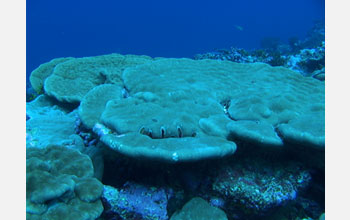5 million trillion trillion.
That's a lot of zeroes but it's how many single-celled microbes there are on Earth. And they affect almost every ecological process.
Though microbes are everywhere and essentially rule the planet, scientists have never been able to conduct comprehensive studies of microbes and their interactions with one another in their natural habitats. A new study provides the first inventories of microbial capabilities in nine very different types of ecosystems, ranging from coral reefs to deep mines.

Rather than identifying the kinds of microbes that live in each ecosystem, the study catalogued each ecosystem's microbial "know-how," captured in its DNA, for conducting metabolic processes, such as respiration, photosynthesis and cell division.
The study employed the principles of metagenomics, which characterizes the DNA content of entire communities of organisms rather than individual species. One of the main advantages of metagenomics is that it enables scientists to study microbes--most of which cannot be grown in the laboratory--in their natural habitats.
Specifically, the microbial study produced the following results:
- A unique, identifying microbial fingerprint for each of nine different types of ecosystems. Each ecosystem's fingerprint was based on its unique suit of microbial capabilities.
- Methods for early detection of ecological responses to environmental stresses. Such methods are based on the principle that "microbes grow faster and so respond to environmental stresses more quickly than do other types of organisms," said Forest Rohower of San Diego State University, a member of the research team. Because microbes are an ecosystem's first-responders, by monitoring changes in an ecosystem's microbial capabilities, scientists can detect ecological responses to stresses earlier than would otherwise be possible--even before such responses might be visibly apparent in plants or animals, Rohower said.
- Evidence that viruses serve as the gene banks for ecosystems. This evidence includes observations that viruses in the nine ecosystems carried large loads of DNA without using such DNA themselves. Rohower believes that the viruses probably transfer such excess DNA to bacteria during infections, and thereby pass on "new genetic tricks" to their microbial hosts. The study also indicates that by transporting the DNA to new locations, viruses may serve as important agents in the evolution of microbes.
Article: Elizabeth A. Dinsdale, Robert A. Edwards, Dana Hall, Florent Angly, Mya Breitbart, Jennifer M. Brulc, Mike Furlan, Christelle Desnues, Matthew Haynes, Linlin Li, Lauren McDaniel, Mary Ann Moran, Karen E. Nelson, Christina Nilsson, Robert Olson, John Paul, Beltran Rodriguez Brito1, Yijun Ruan, Brandon K. Swan, Rick Stevens, David L. Valentine, Rebecca Vega Thurber, Linda Wegley, Bryan A. White, & Forest Rohwer, Functional metagenomic profiling of nine biomes, Nature| doi:10.1038/nature06810






Comments